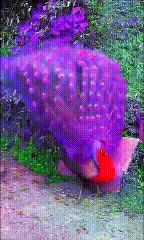HUMAN DISPLAY : CLOTHING
This page is still being developed. I wanted a special page to explore human identity display in terms of physical appearance, specifically clothing – to see if there's any connection i might have missed between human and animal display.
Parent Page : Display Rituals
Our modern behaviours, identities, and belief systems develop mutually and synchronically with our environments, clothes, tools, toys, dances, music, language and stories. Just as it did in traditional times.
 Among animals display is normal when courting.
Among animals display is normal when courting.  This is especially clear among birds, with some pet canaries even developing their own accessories.
This is especially clear among birds, with some pet canaries even developing their own accessories.
Human display behaviour is connected with the fact that most young humans are potentially, permanently sexually active, and behaviour learnt in younger years often lasts a lifetime. (We always repeat learnt behaviour.)
Clothing is a very obvious form of display. All modern human youth-cultures, identify by their appearance.
Identity, Work and Clothes
In traditional times, our everyday appearance was based on what was practical and available; we all wore the same clothes, we had a common appearance. When we compared it with other tribes, it displayed our specialness and we were usually proud to wear it. We enhanced it with ornaments.Since the beginnings of agriculture there was increased diversity in social roles and appearance. But it was especially after the development of steel to make farming tools like ploughs, and wheel hubs and rims around 3,500 years ago, that successful agriculture and trade allowed stable divisions of labour, each with their individual clothing.
Cultures diversified with carpenters, shepherds, blacksmiths, millers, miners, etc. and each group had its own special clothes and i find it significant that previous to modern soap, each group could be identified by their own individual pungent smell. Later we named them Mr. Miller and Mr. Smith.
People had a visible and actual real recognisable identity, developed from practical necessity, and usually passed through generations. Perhaps the unspecialised worker started feeling discontent around this time.
But commonly held abstract beliefs were displayed expressed and practised openly, and the culture as a whole was psychologically secure. And it seems to me, there was a general sense of doing things for the common good, and, except for the tyranny of the powerful, civilisation had a sense of balance.
And this basic situation remained stable. Even through the industrial revolution when workers wore appropriate clothes, and had some sort of specific identity.
But we wanted individual freedom, so the poor could get rich, the baker could become a king, and everyone could get a basic education, and have the freedom to think for themselves and choose their own beliefs. Experts will know more specifics.
Mirrors
There was a huge development around the 1850s, when everyday people could afford the new industrial mirrors.Our self-image suddenly rose from the murky reflection in water and the vague outlines in dark windows, suddenly we had the vivid everyday knowledge of how we looked. This had enormous consequences.
We still needed other people to mirror our psychological identity and how we displayed it – but we could confirm our individual physical display in a mirror.
Significantly, only around ten animals can cope with mirrors.
Identity
First we had the hunt and we were dancing round the fire, Then up until recently, the wood we cut to make the table we sold; and the sheep to give the wool we weaved to make the clothes we bartered. We found identity, purpose, and even satisfaction in our work, it was part of life, life was whole and – even if we lived without knowing our full potential – we felt we knew who we were.We didn't have the freedom of choice which modern social mobility allows. But throughout the development it seems to me everyone played their part, wore their appropriate clothes, and society and cultures fitted together.
Now we exchange work time for money, we all sit on the same assembly line, in front of the same computers, operating the same machines. The supermarkets and mass production have taken over. There's a general lack of job satisfaction. and the shareholders make the profit.
And all choices lead to the same place. The blue collar workers wear ties, the workers wear blue jeans. Individual identity in terms of work appearance has largely dissapeared.
Now we find identity and purpose in our free time activites, hobbies, and holidays.
The fracturing of society into various sub cultures first manifested in the 1960s. I believe this first showed itself with mods, rockers, and hippies, in Britain's first generation without army conscription.
Each of our modern sub cultures has their special accepted style of clothing and social display, dances, music, language and stories. Our free-time display has very little to do with our work identity, it is often a deliberate contrast.
Back to Chapter Three : Civilisation's Habitual Ruts
Back to THE PANORAMA SENSES Priority Pages